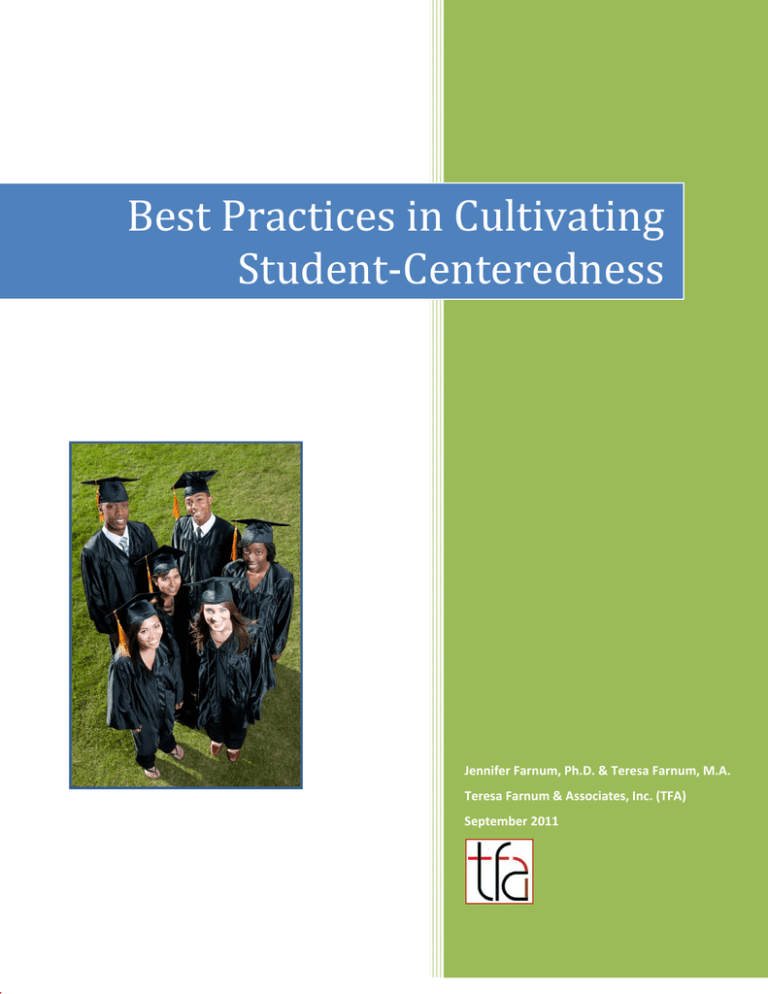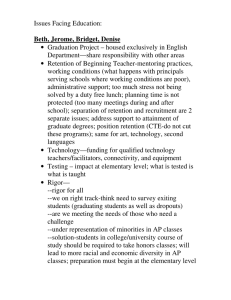Best Practices in Cultivating Student‐Centeredness
advertisement

BestPracticesinCultivating Student‐Centeredness Jennifer Farnum, Ph.D. & Teresa Farnum, M.A. Teresa Farnum & Associates, Inc. (TFA) September 2011 2 Best Practices in Cultivating Student‐Centeredness continue with that experience (Zeithaml, Berry, & Parasuraman, 1996). Many of us in higher education have long been plagued by the nagging sense that there is something amiss with how institutions view—and act upon—their relationships with students. What partially underlies this feeling is that some institutions—whether intentionally or simply out of adherence to a developed culture—adopt a trial‐by‐ fire approach to their dealings with students. Students are expected to intuit college policies, be apprised of and seek out college services appropriate to their needs, and quickly integrate into a foreign system they may have very few protocols for navigating. The best practices listed in this paper are but a few methods of shifting campus cultures to ones that are more student‐centered, thus encouraging student retention and graduation. Best practices are divided into five factors—academic (leadership and faculty), motivational, social/emotional, financial, and procedural—and they derive from both published researched and Teresa Farnum & Associates, Inc.’s (TFA) observations from working with more than 300 client campuses. Research particularly influential in the construction of this paper is listed on page eight, Recommended Reading. Frequently, institutions’ cultural norms require that students adjust and conform to “our way of doing things” regardless of whether those ways are effective and aligned with student needs. Of course, not all institutions hold this attitude; however, this laissez‐faire approach taken by many colleges may play a prominent role in explaining why fewer than a third of Americans today hold a bachelor’s degree (U.S. Census Bureau, 2009) and graduation rates are among the worst in developed countries (Pathways to Prosperity, 2011). “Student‐centered” is a term not often prevalent or practiced in higher education (Bagura, 1998). However, we know that service quality and “customer‐centrism” can greatly affect overall perceptions of any experience—including higher education—and decisions about whether to 3 The Five Factors Academic Leadership Don’t assume “killer courses” are “doing their job” when students fail out. Assess whether those courses are being taught effectively and make sure students are getting the support (e.g., supplemental instruction) they need to succeed. Evaluate the academic curriculum and make sure that core requirements are ones that all students should be required to complete. Encourage full‐time faculty to teach first‐year courses—and change the incentive structure so that it is manageable for them to do so. Ensure that students can progress toward graduation by offering sequential courses in a timely fashion. Make it a goal that students reach the critical cut‐point of 20 credits (see Adleman, 2006) during the first year. Identify, target, and reach out to those who are not on a course for achieving that goal. Schedule courses at times convenient for students—even if those times don’t reflect faculty preferences. Ensure that students have the academic skills to succeed in credit courses through testing and support services. Create reasonable caps on credits required in majors and general education so that graduation in an efficient way is possible. Faculty Provide examples of superior work—whether for projects, papers, tests, etc.—that allow students the opportunity to understand expectations of quality. In online and hybrid courses, track student participation through looking at time spent on discussions, site visits, etc., and identity and flag students who have lower participation in these domains. Provide explicit information in the syllabus about course content, learning outcomes, student expectations, student resources, and grading policies. Regularly gather student feedback on learning outcomes, areas of confusion, etc. and adjust lesson plans and teaching styles accordingly. Provide students with performance feedback within the first few weeks of the semester/term. 4 Recall that active, experiential, problem‐ and project‐based learning are by definition more learner‐ centered than traditional lecture‐style classroom experiences. Emphasize these principles in classroom instruction. Require that students complete a learning styles inventory and personality inventory. Discuss results with students and determine implications and strategies for coursework, study habits, etc. Motivational Offer, encourage, and advertise opportunities to link classroom experiences with career choices via internships, work study, service learning, etc. Practice the principles of “appreciative advising,” which operate on the assumption that motivation is discovered through the process of engaging with advisors, counselors, and faculty who proactively and intentionally cultivate relationships with students. Mandate that students meet with advisors and/or counselors several times a semester. Require that students develop a portfolio, or eportfolio, that captures both their academic experiences and their socio‐emotional milestones. Have students develop a four‐year (or two‐year) plan of study and sign contracts that outline goals and necessary steps to achieve graduation. Recruit “success story” alumni for speaking engagements, mentorships, internship opportunities, etc., paying special attention to matching qualities and characteristics of selected alumni to needs within the student body. For instance, if your institution is struggling with graduating Hispanic students, seek out alumni successes within the Hispanic community. Identify students—especially those in pre‐professional majors—who will not be able to meet minimum academic requirements for their majors and aggressively engage those students in career and major exploration processes prior to “failing out” of first‐choice fields. Social/Emotional Develop, assess, and/or restructure first‐year experience and second‐year experience programs. Ideally, consider moving beyond the first‐ and second‐year levels to creating programming for each academic class year. Understand that family involvement and emotional support is a critical aspect of student success in college, especially within certain cultures. Establish and proactively market programs that encourage familial engagement with the institution. 5 Recognize that different personality types will have different activity preferences and create a suite of options for meaningful social interactions ranging from (for example) competitive, large group activities to small group gatherings. Integrate topics of diversity, multiculturalism, and ethics into the core curriculum and focus on facilitating community and student bondedness through collaborative activities and creating group experiences. Support students spending time with faculty outside of the classroom, for example through lunch programs, trips and excursions, faculty mentor programs, and undergraduate research. Remember that it is not only time spent in the classroom that matters in retention; forming personal connections with faculty bolsters students’ feelings of social integration and connectedness. Mandate common experiences (e.g., summer reading), providing all students with some shared basis for communication. Get networked with the Center for the Study of Collegiate Mental Health, whose aim is to research the psychological well‐being of college students and share strategies and interventions with those involved in the provision of mental health services on campuses (see: http://ccmh.squarespace.com/). Establish peer mentoring programs and provide extensive training and added incentive for mentors. Match roommates based on students’ expressed needs and preferences, making sure that the process of eliciting that information is thorough and well‐researched. Financial Redirect the considerable resources spent on recruiting students with little or no financial aid need (students who will attend college anyway) to providing more robust packages to those that require assistance. Reallocate financial aid packaging from performance‐ to need‐based. Approximately 60% of financial aid is distributed without regard to financial need (College Board Advocacy & Research Center, 2010), a practice that serves to ensure that the most at‐risk students will be lost. Determine how much grant money is being “wasted” on students who do not truly need assistance and reallocate those funds to those in low‐income brackets. One recent national study suggests that institutions spend the same amount of dollars on students who fall into the top two quintiles of family income as they do students on the bottom two quintiles (Haycock, Lynch, & Engle, 2010), a dubious practice that undercuts the prudent allocation of institutional resources. Demystify the FAFSA application process. Remember that students most vulnerable to attrition are those who are economically disadvantaged and, frequently, will have no support or experience with the complicated undertaking of securing financial aid. Have trained, bi/multi‐lingual staff to guide parents and students through the steps. 6 Use econometric modeling to gain a more precise sense of how to optimize resource allocation and make informed decisions about financial aid packaging. Procedural Develop a tracking system in which your institution is systematically reviewing metrics such as overall study body graduation and retention rates versus those of identified at‐risk populations. Implement a one‐stop student service center (both online and at a physical address), integrating (for example) financial aid, registrar, bursar, advising, career services, and student records offices. Evaluate and assess student sentiment regularly. This includes but is not limited to measuring: student satisfaction, program effectiveness, and student needs and preferences. Disseminate and use those results accordingly. Form a campus‐wide retention/student success committee and develop an actionable retention plan with clear tasks, responsible parties, and deadlines. Provide incentives and mandates for collaboration across functional areas (e.g., academic and student services) so that these areas become more unified and seamless for student utilization. Hire a retention coordinator who has authority and financial backing; better still, form a retention office charged with overseeing and directing all institutional retention efforts. Make sure that your institution has an early alert system—one that faculty are required to participate in. Have a clear plan of action for all students who are red‐flagged. Form an early warning committee with members across functional areas such as the registrar’s office, admissions, academic affairs, student affairs, etc. Develop a clear process for handling student exemptions and complaints. Ensure that processes are designed for students and not the convenience of staff. Regularly train frontline staff in the principles of customer service. Want More Information? Contact us at: info@teresafarnum.com or call 603.487.1138. Find us online at: www.teresafarnum.com. 7 Recommended Reading ACT. (2010). What Works in Student Retention? Fourth National Survey. Iowa City, IA: Author. Adleman, C. (2006). The Toolbox Revisited: Paths to Degree Completion From High School Through College. Washington, D.C.: National Center for Education Statistics. AFT Higher Education (2011). Student Success in Higher Education. Washington, D.C.: Author. Bangura, A. K. (1998). Student Centeredness: Conceptualizing and Operationalizing It. Paper contributed to the Mid‐Atlantic Region Historically Black Colleges and Universities Faculty Showcase (ERIC Document Reproduction Service ED423776) Retrieved from: http://www.eric.ed.gov/ERICWebPortal/search/detailmini.jsp?_nfpb=true&_&ERICExtSearch_SearchValue_ 0=ED423776&ERICExtSearch_SearchType_0=no&accno=ED423776. Brotherton, P. (2001). It takes a campus to graduate a student. Black Issues in Higher Education, 18, 1‐32. College Board Advocacy & Research Center. (2011). How Four‐Year Colleges and Universities Organize Themselves to Promote Student Persistence: The Emerging National Picture. Bloomington, IN: Author. College Board Advocacy & Research Center. (2010). Trends in Student Aid. Bloomington, IN: Author. Crosling, G. & Heagney, M. (2009). Improving student retention in higher education. Improving Teaching and Learning, 51(2), 9‐18. Harvard Graduate School of Education. (2011). Pathways to Prosperity. Cambridge, MA: Author. Haycock, K., Lynch, M., & Engle, J. (2010). Opportunity Adrift: Our Flagship Universities Are Straying From Their Public Mission. Washington, D.C.: The Education Trust. Learning Point Associates. (2010). Connecting Research About Access to Higher Education to Practice: An Introductory Guide for Educators. Washington, D.C.: Author. Morris, L. V. & Finnegan, C. L. (2008). Best practices in predicting and encouraging student persistence and achievement online. Journal of College Student Retention, 10(1), 55‐64. Seifert, T. A., Pascarella, E. T., Goodman, K.M., & Salisbury, M. H. (2010). Liberal arts colleges and good practices in undergraduate education: Additional evidence. Journal of College Student Development, 51(1), 1‐22. Spanier, G.B. (2010). Creating adaptable universities. Innovations in Higher Education, 35, 91‐99. Zeithaml, V. A., Berry, L. L., & Parasuraman, A. (1996). The behavioral consequences of service quality. Journal of Marketing, 60(2), 31‐46. 8


